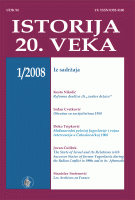PRILOG ISTORIJI SRPSKOG STRELJAŠTVA NA KOSOVU I METOHIJI 1935–1956
BULLSEYE: A CONTRIBUTION TO THE HISTORY OF SERBIAN MARKSMANSHIP IN KOSOVO 1935–1956
Author(s): Ljubomir PetrovićSubject(s): History
Published by: Institut za savremenu istoriju, Beograd
Keywords: marksmanship; Kosovo; sport;
Summary/Abstract: During the two decades, interrupted by the Second World War and the establishment of the revolutionary system, marksmanship in Kosovo evolved from small sporting manifestations of local communities to the top of the class, reflected by participation of individuals in getting the collective bronze medal for Serbia on a national Yugoslav competition in 1956. In both Yugoslav states, marksmanship was stimulated through power structures in the army. During the Kingdom, the military elite was managing the marksmanship clubs, and the postwar military was active in establishing local clubs. Sharpshooters were pressed with expectations of success. Hence the results showing the rise of marksmanship were largely divorced from reality, in which the lack of weaponry, particularly pistols, small number of shooting grounds, and lack of interest of Albanians to give a multiethnic dimension to the competition, were all hindering its development. However, through competition with more successful marksmanship environments, sharpshooters from Kosovo gained the quality needed for success on local, national and international championships.
Journal: Istorija 20. veka
- Issue Year: 2008
- Issue No: 1
- Page Range: 41-57
- Page Count: 16
- Language: Serbian

